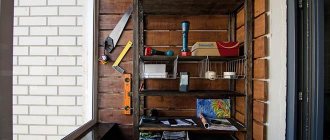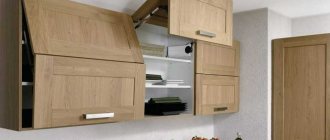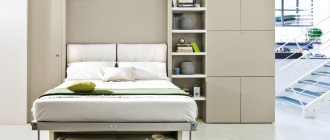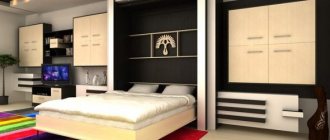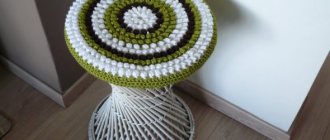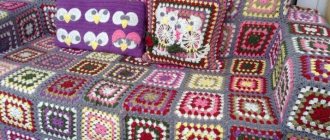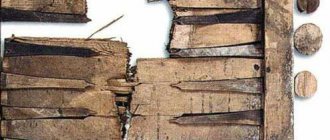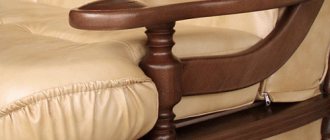Reupholstering a sofa is a rather difficult process, but sometimes necessary. Any upholstered furniture takes on a very unsightly appearance over time, and the sofa is no exception. Various damage and irremovable stains may appear on the upholstery, which makes it necessary to replace it.
Of course, with such a problem, you can contact a workshop and specialists will reupholster the sofa, but you will have to pay an impressive amount of money for some people. But you can take the opportunity to save money and reupholster your upholstered furniture yourself. This is what our article today will be about.
Do-it-yourself sofa reupholstery
When is it necessary to reupholster a sofa?
Damage to upholstered furniture can vary significantly, so it is recommended to first assess the severity of the problem.
Updating the sofa needs to be done in the following cases:
- The upholstery fabric has lost its original appearance. Typically, such damage is associated with the natural wear and tear process of any fabric. In addition, the material can be damaged by pets. This is the simplest type of damage; in this case, a standard replacement of the covers will be sufficient.
The sofa has lost its appearance
- Presence of depressions in the seat. This problem is associated with wear and tear on the soft part of the sofa. In this case, you will need to replace the foam rubber and other layers. If there is a spring structure, it is sometimes necessary to replace or repair the spring units. At the same time, the upholstery does not always need to be removed (if it looks decent), but it will have to be washed.
- The bottom of the sofa is sinking. This happens when there is excessive load on the springs, which quickly penetrate a thin layer of fiberboard. In this case, the structure will have to be disassembled and the bottom replaced (it is better to use plywood).
- Frame deformation. The presence of various cracks in the base of the structure is a more serious problem. In this case, you will need to completely disassemble the sofa and replace the damaged bars.
Reupholstering furniture is much more profitable than buying a new product. In addition, thanks to reupholstery, you can change your sofa beyond recognition by choosing a different color and texture of the covering.
Video - How to get rid of a hole in the sofa
Required Tools
To complete the work, you will need standard tools, since reupholstery does not require specific products. For the process you will need:
- regular furniture stapler;
- screwdriver;
- sharp knife;
- pliers, hammer, scissors, pliers, needle and some other small tools.
For more reliable fastening of materials, it is recommended to additionally purchase high-quality PVA glue.
Types of sofa designs
Table 1. Seat and backrest manufacturing options.
| Option | Description |
| Without springs | On dense furniture foam rubber or latex foam. The second method is considered more practical and convenient, but has a high cost. |
| With springs | With standard springs assembled into a single unit, or with snake springs that support a soft base. These types of structures are the most common. |
The sofa may have a multi-layer structure, which must be studied before reupholstering.
It should be borne in mind that there are other additional layers. For example, modern designs are supplemented with layers of felt and synthetic padding, while older models were stuffed with horsehair, burlap and similar materials.
For the inner layer you need to purchase padding polyester in a roll.
Stage II - removing old upholstery
When the sofa appears in front of you in the form of separate parts, you need to carefully remove everything that is old and has lost its visual appeal and functionality. Be prepared for the fact that you will have to get rid of more than one hundred staples from a furniture stapler. This process can become very painstaking and annoying if you do not prepare all the necessary tools in advance:
- First of all, the bracket will need to be pryed off with something; a thin flat-head screwdriver will do for this;
- Now you need to remove it; pliers or round nose pliers will do for this;
- A utility knife may come in handy.
The work will progress much faster if you first pry up all the staples on each part and then remove them. There will be no time wasted changing working tools. To avoid finding staples later in the most unexpected corners of the apartment and to avoid injury, immediately prepare a garbage bag.
When removing fasteners, be careful not to cut the fabric itself. At the stage when you need to cut new upholstery, you can use old fragments as patterns. Under the fabric you will find filler. It can be foam rubber or other materials. In older models, filler often fills the space between the springs. You need to carefully pull it out too.
When starting this stage, after you have prepared the necessary tools, we recommend that you cover the area of the floor on which you will be working with oilcloth. The old filler can simply crumble in your hands and turn into dust, which will quickly spread throughout the apartment. There will be a lot of garbage.
Standard version of the sofa with a zigzag block
In order to properly reupholster a sofa, you need to know the exact location of the layers of material. In the standard version of the product, the following sequence occurs:
- Plywood frame or wooden slats. Of course, the first option is more durable, but has a high cost, so pine slats or bars are often used to make the frame. They are fixed to each other through grooves using glue. Sometimes, for greater reliability, the structure is reinforced with metal corners.
sofa frame
- The base is under the block (spring). For such purposes, special planks are used - lamellas, plywood and fiberboard. The first option is the most expensive, so craftsmen, trying to save money, use plastic strips, which quickly crack. Another option for reducing the cost of a sofa is to install slats with large gaps, as a result of which the structure quickly loses its elasticity and the slats sag greatly.
- Spring block. The design can be with independent or dependent springs. In the second case, the sitting will be more comfortable; it is also called massage.
- Felt or any thick fabric. The presence of such a layer prevents deformation of the foam rubber by springs.
- Furniture foam rubber. It is important that in addition to density, such a material is durable. This means that after any load it should recover quickly. In case of replacement, thicker material can be used, but this is not possible with a folding design.
Durable furniture foam
- Sintepon. This soft lining prevents the foam from rubbing with fabric. To prevent it from forming into lumps during use, it is usually fixed to the previous layer with glue.
- Fabric covering. It can be anything, but when choosing a new one, choose dense materials that will not crumble or deform during processing.
Important point! Some craftsmen prefer to line them with a double layer of padding polyester for greater softness.
How to choose an ottoman
You can decide which is better, an ottoman or a bed, only by knowing the parameters of the room and the features of its use. Here are some arguments:
- An ottoman and a sofa are cheaper than a bed with a mattress.
- An ottoman is more compact than a bed, it looks good and is conveniently located in a corner or along the wall.
- Folding models are especially relevant for the living room or children's room, where free space is necessary.
- A large bed and bedding inevitably turn the room into a bedroom, and a sofa and ottoman make it multifunctional.
- The bed is more durable than an ottoman because it can be replaced with a mattress. You will have to get rid of the ottoman when it loses its elasticity and shape.
The Soviet ottoman often had a sleeping place consisting of several pillows and had an unpresentable appearance. Modern models have come a long way from this prototype, and therefore the ottoman is relevant again in 2021.
When choosing a specific ottoman model, pay attention to the following parameters:
- Folding mechanism: in addition to the “ottoman” of the same name, a roll-out couch, a Eurobook and others are used.
- The base material must be reliable, this parameter is especially important for folding models. The highest quality ones are made from solid wood.
- Availability, shape and height of backrests. Choose corner models especially carefully: the location of the backs determines in which corner the ottoman can be placed.
- Mattress type: independent spring blocks are the most expensive and comfortable; nothing will put pressure on the side. The usual spring mechanism adapts less well to the shape of the body, and soft fillers such as thick foam rubber are available, but are short-lived. What is better is up to you to decide.
- The practicality of the upholstery material and the ability to remove covers for washing are especially important for children's rooms.
- The shape, color, materials must correspond to the design of the room.
Before purchasing, be sure to evaluate what the model looks like in real life: pictures in catalogs may not accurately convey color and create illusions regarding size.
Dismantling the sofa
The process of reupholstering a sofa should begin by disassembling it. At this stage, the extent of damage to the various layers of the structure can be assessed, for which the following tools will be required:
- screwdriver for bolts (if present);
- staple remover or flat-head screwdriver (to remove upholstery);
- measuring tape (measuring the thickness and height of the pillows).
Step one: reupholstering folding products necessarily requires reaching the same height of the backrest and seat, because the mechanism is designed only for certain parameters of the pillows. It is necessary to take measurements from the pillows in advance if they are to be replaced.
We take measurements from pillows if they are supposed to be replaced
Step two: separate the fabric from the sofa frame using a screwdriver or staple remover. If the staples are difficult to remove, you can use pliers at this stage. If the fabric is to be reused, it should be separated with extreme care. Moreover, if there are even minor signs of wear, then it is better to replace the upholstery, otherwise in a few months the sofa may need a new reupholstery.
Removing fabric from the sofa
Step three: remove various contaminants and separated fragments of filler. At this stage it is necessary to assess the scale of the problem. It is advisable to keep the frame and all its layers in the same form (if possible). In some cases, replacement of obsolete materials will be required.
Freeing the frame from fillers
Step four: carefully examine the condition of the spring block (if the sofa assumes the presence of springs). A fairly common problem is the springs breaking, causing them to bulge. In addition, it is often necessary to observe the breakdown of fiberboard on the frame itself. If the above damage is present, the unit should be dismantled. It is fixed to the frame frame using metal brackets, so the procedure is performed using a flat screwdriver.
Broken spring
Breakage of fiberboard on the frame
Option for breaking a sofa with zigzag springs, which should give elasticity to the seats
Choosing a filler
If the inside of the sofa is perfectly preserved and does not require replacement, then this step should be skipped, going straight to creating a pattern and reupholstering.
If the sofa has exhausted its resources, then its filler should be replaced, which can be of the following types:
Periotec
Non-woven material that includes natural fibers (coconut, flax, corn) and artificial components that hold their shape well and also provide elasticity and strength. The material is hypoallergenic, and its characteristics are quite capable of competing with a spring block.
Sintepon
A more budget-friendly option in the form of non-woven fabric, which is sold in rolls. By increasing the layers of padding polyester, you can adjust the degree of rigidity of the sofa itself. It is usually used as a layer between upholstery and polyurethane foam, which makes the surface soft.
Polyurethane foam
A highly porous material that holds its shape well, while being soft and comfortable enough to fill the seat and back of the sofa. It is absolutely safe for health, has a long service life, does not accumulate dust and unpleasant odors.
Spring block
Made to order according to your measurements, or selected from those options that are available. Keeps its shape perfectly and does not sag. It needs a felt layer that will protect the foam from the effects of springs.
Struttofiber
It is called “non-woven independent springs”, which perfectly retain pressure, distributing it evenly over the entire surface. It is one of the most practical and durable fillers today.
To calculate the required amount of filler, you need to measure the dimensions of individual parts of the sofa, as well as determine the thickness of the filler itself. If you take thinner options, such as padding polyester or holofiber, then you need to initially determine how many layers there will be.
If you are in doubt about which filling will have the best qualities specifically for your sofa, then try forming a sandwich from struttofiber, polyurethane foam and felt. This combination will be the most advantageous, since the struttofiber holds its shape perfectly, the felt protects it from sagging at a specific point of constant pressure, and the top layer of polyurethane foam provides the necessary rigidity.
Sofa restoration
After removing the old upholstery and disassembling the structure, you can begin the repair itself. The extent of work to restore the sofa will depend on the complexity of the damage; below we will look at the most common of them.
Frame repair
You will need to prepare the following materials and tools:
- wooden blocks (to replace damaged ones);
- plywood sheets;
- metal dowels;
- wood glue;
- vice;
- nails.
Step one: replace the damaged frame elements with new wooden blocks. It is important to pre-condition the material for several days at room temperature.
Replacing old unusable bars
Step two: take a wooden frame using the same tenon and groove principle, using glue. It is better to further strengthen the structure with the help of metal caps.
Use of metal chokes
Step three: for the base of the spring block, you can take sheets of plywood 150 centimeters wide and about 200 centimeters long. Next, you need to cut out two rectangles according to the dimensions of the structure, then place them on the frame (pre-coat them with glue). Then the plywood should be carefully nailed. It is important to choose the optimal length of nails so that they do not protrude from the outside of the frame. The junction of the sheets should be reinforced with a strip.
Plywood for base
Repair and fastening of the spring block
To work you need to prepare the following:
- U-shaped brackets (you can buy them at a hardware store or make them yourself from wire);
- nylon banners;
- strong thread;
- awl;
- hammer;
- felt or any durable fabric.
Brackets for fixing springs
Step one: we fix the springs using metal brackets with sharp ends, after which they need to be driven in with a hammer. An ordinary stapler cannot cope with such a process.
Fixing the springs
Step two: the springs must be additionally secured with nylon constrictions. You can use a thick rope, which is secured with the same brackets. In this case, it is important to achieve optimal tension so that it does not deform the springs.
Nylon thread for attaching springs
Step three: felt should be placed as the top layer. If you don't have one, you can even use old carpet. For greater density, it is advisable to take a double layer of material and then cut it to size. It is fixed using the same dense thread, and holes are made with an awl or a nail. A distance of 35 millimeters is maintained between stitches.
Holes can be made with an awl
Step four: a layer of foam rubber is laid next, and then padding polyester. Along the entire perimeter, the materials are fixed with glue and then hammered in with nails.
If you are on a limited budget, you can use an old but thick blanket
How much material to buy
After the material has been selected, it is necessary to calculate how much of it to purchase. The easiest way to calculate the amount of fabric is to add the length and width of the sofa. Double the resulting amount. For example, a sofa measuring 2.5 x 1.8. In this case, you need to purchase about 7 meters.
To make the calculation as correctly as possible, it is recommended to adhere to the following instructions:
- Take accurate measurements of all elements of the sofa. In this case, you need to measure the longest and widest parts of the back, seat, armrests and pillows, adding a few centimeters for seam allowances.
- Draw a diagram of the sofa, be sure to ensure that the parts are positioned correctly.
- Add all vertical values and divide by 100. The resulting value is approximately equal to the required length of fabric in meters.
- To determine the width of a piece of fabric, you need to take the widest part from the horizontal piece.
- For a more comfortable cut, it is recommended to add 1 meter for every 5 meters to the resulting length and width.
The approximate material consumption depends on the type of sofa:
- 2-seater - about 10-14 sq. m;
- 3-seater - up to 15 sq.m. m;
- kitchen corner - up to 6 sq. m;
- corner sofa - about 22 sq. m.
Material consumption increases if a complex pattern is applied to the fabric, which must be selected when connecting elements of the sofa, in the absence of a project and pattern.
Sofa cover
If the old sofa cover has become unusable, it will need to be replaced with a new one. This is the most interesting and creative stage of reupholstering a product.
What material to choose for upholstery?
First you need to decide on the type of fabric. An important condition is not only the decorative appearance, but also the good resistance of the fabric to various damages.
Table 2. Types of fabrics for upholstery of upholstered furniture.
| View, illustration | Description |
Genuine Leather | The obvious advantages of such a material include resistance to wear and a noble appearance. But at the same time, it is not always possible to find leather of decent quality on sale; moreover, such material has a rather high cost. |
Cotton | An equally common material that is often used for upholstering upholstered furniture in a children's room. The main argument in favor of purchasing this fabric is environmental friendliness. In addition, cotton has a budget price. |
Jacquard | This is an excellent choice of material for upholstering a sofa, because jacquard is wear-resistant and does not wear out over time. The only drawback of this option is the high price. |
Flock | Pet lovers will especially appreciate this material. Claw marks are absolutely invisible on its surface. Flock is completely safe, environmentally friendly, and, if necessary, various contaminants can be quickly removed from such a velvety surface. |
Tapestry | Sofas were covered with this material several centuries ago. It has an attractive appearance and a variety of shades and their combinations. The main disadvantage of the fabric is its poor resistance to ultraviolet rays, so this sofa is not recommended for installation on a terrace or veranda where the sun hits. The price of tapestry fabric is quite high, which is also a disadvantage. |
Chenille | This material is produced on an adhesive or fabric basis. In the first case, the fabric may become deformed upon contact with water. The second option is more reliable and does not lose its appearance even with wet cleaning. |
Velours | Belongs to the category of the most popular materials for covering upholstered furniture. It is often chosen due to its good quality at low cost. Velor has a long service life and a soft surface that is pleasant to the skin. |
Synthetic leather | This is a budget option for creating a leather-like sofa. This material consists of a cellulose base coated with polyurethane. Faux leather does not deform when exposed to sunlight; moreover, it does not require special care - it is enough to wipe it with a damp cloth. On sale you can find quite high-quality options for such material, for example, eco-leather. Its feature is the ability to pass air. |
Important point! Of course, the first priority is to choose a durable material that will last for many years. But it is not recommended to purchase too coarse fabrics - hard, unpleasant to the touch materials. They not only reduce the pleasure of contact with the furniture, but also give the sofa an even older look.
A sofa is furniture for relaxation, and it should be comfortable.
An equally important point when choosing fabric is the room where you plan to use the sofa. For example, if we are talking about the kitchen, then you should immediately abandon all kinds of fabric options - they will quickly become unusable if food or liquids regularly get on them. You should not choose textile covers for various outdoor sofas, because they cannot repel moisture. Leatherette of any type is ideal for such conditions.
Pattern of covers
Once the fabric has been selected, you can begin the pattern making process. This is a very important stage of reupholstering a sofa, which is usually given special attention.
Table 3. Methods for creating a pattern
| Way | Description |
Based on previous cases | It is necessary to attach all the dismantled upholstery parts to the fabric and cut out the parts according to this sample. Do not forget that for connection you should leave a distance of about 5 centimeters around them. You can first attach such a pattern to the frame, and only then cut it out. |
Measuring every detail of the structure | To take measurements, it is necessary to remove all small elements from the sofa, including: pillows, armrests. After which they are measured, adding 5 centimeters on each side, and then these values are transferred to the fabric. Each cut piece will need to be placed on a specific spot on the sofa to ensure the measurements are correct. This method is labor-intensive, so it is used less often. |
Important point! Experienced experts recommend checking the correct measurements several times before creating a pattern - this will avoid further problems with the upholstery of the sofa.
Sewing covers
In order to sew high-quality sofa covers, you need to have basic cutting and sewing skills. Otherwise, you can only ruin the material.
Important point! If the material is too expensive, it is better not to take risks and contact a studio that specializes in making covers.
Step one: all parts (especially those with large pile) should first be swept by hand so that they do not move.
Large parts must be swept by hand
Step two: after the sour cream parts should be sewn on a sewing machine according to the outline.
Next we will use the machine,
Step three: the edges of the stitched covers must be processed with an overlocker. If you don't have it, you can use a zigzag.
Finishing edges with overlock
Important point! In the process of sewing covers made of genuine leather or leatherette, difficulties may arise with the needle, so the surface of the fabric under the foot of the sewing machine is treated with oil.
Securing the covers
Upon completion of all repair work to restore the structure and after sewing the covers, you can begin the final stage - reupholstering the sofa with fabric. The final appearance of the product will depend on the correctness of such actions. In this matter, it is important not to rush and be patient.
Step one: if the design of the sofa involves the presence of decorative buttons, then their location should be marked on the foam rubber. Next, you need to fix the foam rubber on the frame and put a layer of batting or padding polyester on top of it, fixing it with glue.
Markings on padding polyester
Step two: after that you need to try on the covers on the frame of the sofa again, because it is at this stage that you can still adjust the parts to the required sizes (if necessary, even sew up the corners of the covers). Do not be afraid if the cover is difficult to put on the structure, because during upholstery it must be pulled as tightly as possible.
Trying on covers
Step three: upon completion of all sizing work, you need to pull the covers back onto the frame and carefully straighten them. In this case, even seams should be located along the edges of the parts. At this stage, on the back side, which is not yet covered with upholstery material, you should fasten the decorative buttons along the marks, threading them through to the front side.
Final sizing
Step four: now you can begin the process of attaching the covers with staples - a special stapler is used for this. This should be done carefully, constantly pulling the fabric with one hand. The bevel should be smooth in the form of a circle (especially when processing armrests). It is recommended to start fastening with staples from the middle part, which will allow you to sew in excess fabric along the edges if necessary.
Attaching the covers
Step five: when covering the back of the sofa, you must carefully use scissors to make holes for attaching the bolts. In addition, it is recommended to additionally hammer the staples.
The staples must be firmly driven into the base
Step six: upon completion of the stretching, it is necessary to secure a dense lining material on the wrong side. After stretching, it is also fixed using a stapler.
The finished sofa after finishing the covering
Material selection
First of all, you need to decide what fabric will be used for the upholstery. The table describes the advantages and disadvantages of each material.
| Material | Advantages | Flaws |
| Genuine Leather |
|
|
| Cotton |
| wrinkles and wears out quickly |
| Jacquard |
| quite expensive |
| Flock |
|
|
| Tapestry | adds sophistication to furniture |
|
| Velours |
| wipes quickly |
| Chenille |
|
|
| Arpatek |
|
|
It is recommended to avoid synthetic and rough fabrics. You should not buy material with a strong odor; this is a sign of the use of toxic and low-quality dyes.
Advantages of reupholstering furniture yourself
Restoring upholstered furniture with your own hands has obvious advantages:
- Possibility to choose any fabric for upholstery and subsequent decoration of the sofa.
- Reupholstering a sofa is not only a good way to improve the appearance of the product, but also an opportunity to immediately repair the frame.
- Most models of sofas made in the USSR are distinguished by a strong frame, which cannot be said about some modern options. That is why many craftsmen prefer to use such designs as a basis.
- Restoring an old sofa will require minimal costs, especially if you do not have to involve workers. In addition, some of the inner layers can be replaced with old unnecessary materials.
Where to put and how to use the couch
Certain types of couches are appropriate in absolutely any corner of the home: in the hallway, living room, bedroom, nursery, office on the balcony or loggia, even in the yard. Most models look organically with a long end to the wall or independently, in the free space of the room.
This furniture is convenient for reading a book, knitting, welcoming guests, or just relaxing. Take a laptop, tablet and headphones with you, and you won’t notice how your body will completely relax and doze will creep in unnoticed. In the bedroom, it is convenient to place a blanket or blanket on the couch, and in the nursery, the mother can comfortably breastfeed the baby or take a nap if the child wakes up often.
Let's sum it up
If an old sofa has lost its original appearance, you should not immediately buy another one when you can try to restore it. Following the instructions will allow you to give the structure any shape, and purchasing new fabrics will update not only the sofa itself, but the entire interior!
You may be interested in information on how to assemble a sofa yourself at home. In a special article we will look at various options for modern sofas and assembly instructions.
What is needed?
This kind of work is painstaking, so everything you need must be prepared in advance. To change the upholstery of a sofa, you will need:
- Wrenches, screwdrivers and pliers. Furniture will need to be disassembled.
- Side cutter and anti-stapler. Such devices easily remove old sofa upholstery. But if it is not possible to buy these tools, then an ordinary knife and scissors will do.
- Large scissors, a small bar of soap, thread and a sewing machine. It is advisable to choose tailor's scissors, since they are easier to cut dense material. Soap will allow you to perfectly mark the line of the future cut.
With the help of such devices, you can change the upholstery of a sofa at home. In order for all the work to be completed accurately, you must follow simple instructions. If it is strictly followed, success is guaranteed.
Features of skin tightness
Genuine leather has good shock-absorbing qualities and is stretchable. Thanks to this, sitting on such seats is convenient and comfortable, but over time the material stretches, forming bubbles. In addition, strong tension can cause holes to tear. In order for the upholstery to remain presentable for as long as possible, it must be nailed in a continuous line as far as possible from the edge of the frame - this will leave enough space for tightening when stretched, which will allow restoration without complete disassembly of the product.

